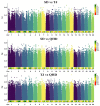Genetic Diversity and Signatures of Selection in the Roughskin Sculpin (Trachidermus fasciatus) Revealed by Whole Genome Sequencing
- PMID: 37998026
- PMCID: PMC10669622
- DOI: 10.3390/biology12111427
Genetic Diversity and Signatures of Selection in the Roughskin Sculpin (Trachidermus fasciatus) Revealed by Whole Genome Sequencing
Abstract
The roughskin sculpin (Trachidermus fasciatus) is an endangered fish species in China. In recent years, artificial breeding technology has made significant progress, and the population of roughskin sculpin has recovered in the natural environment through enhancement programs and the release of juveniles. However, the effects of released roughskin sculpin on the genetic structure and diversity of wild populations remain unclear. Studies on genetic diversity analysis based on different types and numbers of molecular markers have yielded inconsistent results. In this study, we obtained 2,610,157 high-quality SNPs and 494,698 InDels through whole-genome resequencing of two farmed populations and one wild population. Both farmed populations showed consistent levels of genomic polymorphism and a slight increase in linkage compared with wild populations. The population structure of the two farmed populations was distinct from that of the wild population, but the degree of genetic differentiation was low (overall average Fst = 0.015). Selective sweep analysis showed that 523,529 genes were selected in the two farmed populations, and KEGG enrichment analysis showed that the selected genes were related to amino acid metabolism, which might be caused by artificial feeding. The findings of this study provide valuable additions to the existing genomic resources to help conserve roughskin sculpin populations.
Keywords: Trachidermus fasciatus; genetic diversity; population structure; selective sweeps.
Conflict of interest statement
The authors declare no conflict of interest.
Figures









References
-
- Wang J.Q., Cheng G., Tang Z.P. The Distribution of Roughskin Sculpin (Trachidermus fasciatus) in Yalu River Basin, China. J. Fudan Univ. 2001;40:471–476. (In Chinese)
-
- Wang J.Q. Advances in studies on the ecology and reproductive biology of Trachidermus fasciatus Heckel. Acta Hydrobiol. Sin. 1999;23:729–734. (In Chinese)
-
- Yue P.J., Chen Y.Y. China Red Data Book of Endangered Animal Species. Science Press; Beijing, China: 1988. (In Chinese)
-
- Wang J.Q., Pan L.D., Liang T.H., Gan H.C. Preliminary Study on Embryonic Development of the Roughskin Sculpin, Trachidermus fasciatus. J. Fudan Univ. 2004;2:250–254. (In Chinese)
Grants and funding
LinkOut - more resources
Full Text Sources
Miscellaneous

